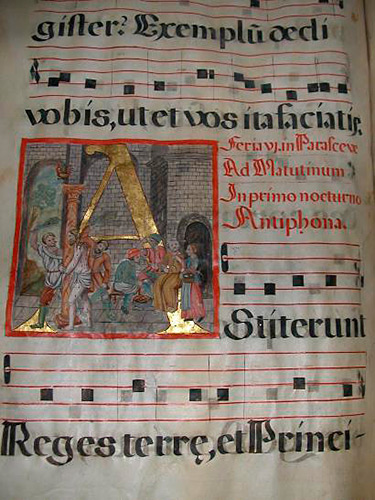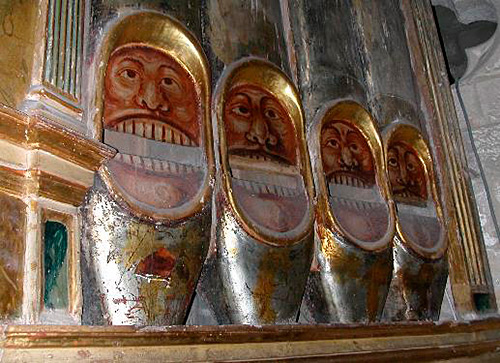September 24
Global Seminars & Invited Speaker Series
VIANA IN ITS VIII CENTENARY: CULTURE AND HERITAGE
Music and musicians: the music chapel of Santa María de Viana, XVI-XIX centuries.
Juan Cruz Labeaga Mendiola
PhD in Art History
Throughout its history, the church of Santa María de Viana had a music chapel, made up of professional singers and musicians at the service of worship, paid for with parish funds. This chapel is documented from the 16th century onwards. After moments of splendor during the XVII and XVIII centuries, it was reduced to the minimum expression in the XIX century.
During the 16th century a period of material and spiritual prosperity began in Viana. From the middle of that century it began to occupy an important place, coinciding with the provisions of the Council of Trent, which promoted music, including some decrees on chant and the making of choral books according to the new liturgical norms. Thus, Bishop Juan Bernal de Luco ordered, in his pastoral visit to Viana in 1549, to make missals and psalteries, and that the high mass be sung with organ accompaniment. A few years later, in 1569, another bishop, Juan de Quiñones, clearly favored the creation of a music chapel, as he ordered the provision of a cantor and an organist. It was often difficult to find organists, who generally came from Zaragoza, Toledo and Burgos. This instrument required a very special attention and accompanied alone the chanting of beneficiaries and chapel in liturgical functions, as other instruments had not yet been introduced. At that time it was based on flute registers and differences or mixtures and was distinguished by the softness and clarity of its sounds.

One of the main obligations of the clergy of the chapter was to sing the official document Divino in the liturgical celebrations. Because of this, according to the Constitutions of the Chapter, the aspiring beneficiary was subjected to a singing exam. During the second half of the 16th century, the musical chapel functioned modestly, since the architectural works consumed a large part of the budget, and it was not until 1556 that a permanent cantor appeared for the first time in the service of the church. For this reason, in addition to dancers and car performers, singers and musicians from abroad were hired for the great festivities.
With the turn of the century, a moment of splendor was experienced, following the tradition of the previous century: aspiring beneficiaries were subjected to a singing exam, including the Constitutions of the Cabildo of 1640, which were based on previous ones, the obligations of each beneficiary with respect to singing. Also the musical chapel, formed by musicians and singers, reached a great boom in this century. Its members generally came from the same province or neighboring provinces, and were rarely from the locality itself. At the beginning of the 17th century, it was reduced to a minimum: organist, alto, contrabass, tenor and treble. Towards the middle of the century, the number of musicians and singers increased considerably, which was maintained until the end of the century. Although it varied from one year to another, the chapel usually consisted of the following elements: a maestro de capilla, an organist, two tenors, two altos, two altos, three trebles, two cornets, a bass, a sackbut and, sometimes, a harpist. As a general rule, the musicians changed their destination very often because they aspired to more important and better paid posts, and they were rarely clerics. Thanks to the works cited in an inventory of music books and notebooks from 1645, we know part of the musical repertoire performed by that ensemble. This list includes partially the works that were sung during the second half of the 16th century, motets, masses, magnificats and salves of the best polyphonists of the Andalusian, Castilian and Aragonese schools, as well as of the Roman school. In addition to this classical repertoire, the Chapel sang carols composed expressly for the festivities with ad hoc lyrics. Several composers and copyists of books with polyphonic musical works are also documented, among them some musicians of the Chapel, organist and choir masters. There is news that the chapel masters composed works for some solemn days, and there is also evidence of the work of copyists, who were paid for copying scores.

However, because its maintenance required large financial outlays, it was almost completely dissolved at the end of the sixteenth century in order to finance the enormous construction of the ambulatory, sacristy and other facilities. It was decided to keep the essential musicians and singers, but to reduce their salaries considerably. Thus, in 1700 the musical institution was reduced to an organist and the chantre.
It was not until the middle of the 18th century that the ensemble was restored as in its most glorious period of the previous century, partly promoted by the parish procurator, seconded by the church chapter, and partly due to the insistence of the bishops, who in their pastoral visits noted the lack of compliance with the provisions of Trent regarding music in liturgical celebrations, both with regard to the music chapel and the obligations of the beneficiaries. In order to clarify the obligations of the musicians, the conditions referring to the days and functions in which they had to perform were written down, being these numerous throughout the year. But this restoration was quite ephemeral due to the high costs that its maintenance required, and even within the Cabildo there were those in favor of moderating the expenses, asking that only what the bishops ordered in their pastoral visits with respect to the singing be attended to.

The repertoire throughout the eighteenth century reflected the Italianizing influence in the Spanish musical panorama. Likewise, Viana no longer included, as in previous centuries, classical polyphonic composers, but rather other composers of the time. The conditions of the contracts with the organists expressed their obligation to compose certain compositions on certain solemn days. Although no sheet music has been preserved in the parish, the titles of the compositions mentioned in some lists of works indicate that violins, flutes and horns were widely used, and that in addition to masses, psalms, lamentations and other works in Latin, arias and carols were sung in the new style. Among the music played in Viana, in accordance with what was happening in the rest of Spain, there was also profane music, with letrillas in vulgar language , introducing in the refrains the style of seguidillas, bolero and tiranas, which motivated successive complaints to the bishoprics.
In spite of the difficult economic and political status that Spain experienced throughout the 19th century, at the beginning of the nineteenth century we still see how religious functions in the city are accompanied by the music chapel and how different musical instruments are ordered in Madrid or how the parish organ is repaired. However, the disentailment of church property and the suppression of the chapter would affect the status of the music chapel, which at the end of the century was reduced to the minimum expression of the organist, with a modest salary and who exercised the functions of teacher, and the local tiples children, whom he himself taught and directed.
